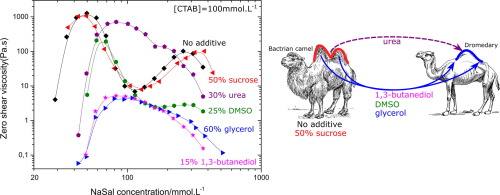Journal of Colloid and Interface Science ( IF 9.4 ) Pub Date : 2018-01-06 , DOI: 10.1016/j.jcis.2018.01.024 Karl Jan Clinckspoor , Laila Lorenzetti Jorge , Heinz Hoffmann , Edvaldo Sabadini

|
Hypothesis
It is known that additives like glycerol and sucrose lead to the swelling of aqueous bilayer L phases. The swelling of the L phases can be explained by the increase of the refractive index of the mixed solvent, which lowers the van der Waals attraction between the bilayers. Afterwards, the undulation forces between the bilayers can push them apart.
This hypothesis was previously extended to wormlike micelles (WLM) of cetyltrimethylammonium bromide (CTAB) and sodium salicylate (NaSal). These types of self-assembly structures have viscoelastic properties, and the zero shear viscosity of these solutions is dependent on the molar ratio NaSal/CTAB, R. At R = 0.6, R = 1.0 and R ≈ 2.6 the viscosity goes, respectively, through a maximum, a minimum and another maximum. These viscosities can be explained by differences in relaxation mechanisms predominant in each region. Similarly to what is observed to bilayer L phases, the additives would change the interaction between the WLM, affecting the relaxation processes of each region, altering the profile from two maxima and one minimum to a single maximum in viscosity.
In the present manuscript, it is investigated whether it is only the refractive index, other solvent properties, or a combination of several factors that induce these changes in WLM. For this, several additives, forming binary mixtures with water, were studied, through rheology of CTAB/NaSal and calorimetry of tetradecyltrimethylammonium bromide (TTAB)/NaSal.
Experiments
Herein, we present the zero-shear viscosity diagrams of NaSal and CTAB with glycerol, sucrose, dimethyl sulfoxide, 1,3-butanediol and urea combined with water. Additionally, isothermal titration calorimetry was used to obtain the variations of enthalpy for formation of WLM of TTAB and NaSal in mixtures of water and such additives.
Findings
Based on our data, only the refractive index match is not enough to explain the rheological and calorimetric behaviors of the WLM. For instance, sucrose has little effect on the micelles, even at the same refractive index match conditions. Additional characteristics, such as dielectric constant, the cohesivity of the solvent (here symbolized by the Gordon parameter), and the interactions of the additive with the micelles, have to be considered to better describe the results.
中文翻译:

水溶液二元体系中烷基三甲基溴化铵-水杨酸钠蠕虫状胶束的流变和量热研究
假设
众所周知,甘油和蔗糖等添加剂会导致双分子层L溶胀阶段。L的肿胀相可以通过增加混合溶剂的折射率来解释,这降低了双层之间的范德华吸引力。之后,双层之间的起伏力会将其推开。
该假设先前已扩展到十六烷基三甲基溴化铵(CTAB)和水杨酸钠(NaSal)的蠕虫状胶束(WLM)。这些类型的自组装结构具有粘弹性,这些溶液的零剪切粘度取决于NaSal / CTAB,R的摩尔比。在[R = 0.6,[R = 1.0和- [R ≈2.6粘度推移,分别通过一个最大值,一个最小值和另一个最大值。这些粘度可以通过在每个区域中主要的松弛机理的差异来解释。类似于对双层L的观察 阶段,添加剂将改变WLM之间的相互作用,影响每个区域的松弛过程,从而将粘度的分布从两个最大值和一个最小值更改为一个最大值。
在本手稿中,将研究导致WLM发生这些变化的仅仅是折射率,其他溶剂特性还是多种因素的组合。为此,通过CTAB / NaSal的流变学和十四烷基三甲基溴化铵(TTAB)/ NaSal的量热法,研究了几种与水形成二元混合物的添加剂。
实验
在这里,我们展示了NaSal和CTAB与甘油,蔗糖,二甲基亚砜,1,3-丁二醇和尿素与水混合后的零剪切粘度图。另外,使用等温滴定量热法获得在水和此类添加剂的混合物中形成TTAB和NaSal的WLM的焓的变化。
发现
根据我们的数据,仅折射率匹配不足以解释WLM的流变和量热行为。例如,即使在相同的折射率匹配条件下,蔗糖对胶束的影响也很小。为了更好地描述结果,必须考虑其他特性,例如介电常数,溶剂的内聚性(在此由Gordon参数表示)以及添加剂与胶束的相互作用。











































 京公网安备 11010802027423号
京公网安备 11010802027423号